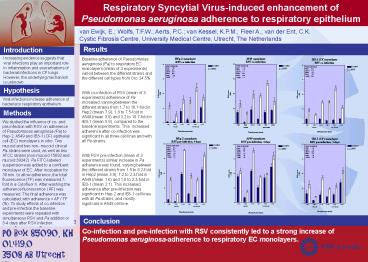Geen diatitel - PowerPoint PPT Presentation
1 / 1
Title: Geen diatitel
1
Respiratory Syncytial Virus-induced enhancement
of Pseudomonas aeruginosa adherence to
respiratory epithelium
van Ewijk, E. Wolfs, T.F.W. Aerts, P.C. van
Kessel, K.P.M. Fleer A. van der Ent, C.K.
Cystic Fibrosis Centre, University Medical
Centre, Utrecht, The Netherlands
Results
Introduction
Increasing evidence suggests that viral
infections play an important role in inflammation
and exacerbations of bacterial infections in CF
lungs. However, the underlying mechanism is
unknown.
Baseline adherence of Pseudomonas aeruginosa (Pa)
to respiratory EC monolayers (mean of 3
experiments) varied between the different strains
and the different cell types from 0 to
24.5. With co-infection of RSV (mean of 3
experiments) adherence of Pa increased, varying
between the different strains from 1.7 to
16.1-fold in Hep2 (mean 7.9), 1.8 to 7.5-fold in
A549 (mean 3.8) and 3.2 to 10.7-fold in IB3-1
(mean 5.9), compared to the baseline experiments.
This increased adherence after co-infection was
significant in all three cell lines and with all
Pa-strains. With RSV pre-infection (mean of 3
experiments) similar increase in Pa adherence was
found, varying between the different strains from
1.5 to 8.2-fold in Hep2 (mean 3.9), 1.2 to
2.3-fold in A549 (mean 1.6) and 1.8 to 2.3-fold
in IB3-1 (mean 2.1). This increased adherence
after pre-infection was significant in Hep-2 and
IB3-1 cell lines with all Pa-strains, and mostly
signifcant in A549 cell line.
Hypothesis
Viral infections increase adherence of bacteria
to respiratory epithelium.
Methods
We studied the influence of co- and pre-infection
with RSV on adherence of Pseudomonas aeruginosa
(Pa) to Hep-2, A549 and IB3-1 (CF) epithelial
cell (EC) monolayers in vitro. Two mucoid and two
non- mucoid clinical Pa-strains were used, as
well as two ATCC strains (non-mucoid 15692 and
mucoid 39342). Pa FITC-labeled suspension was
added to a confluent monolayer of EC. After
incubation for 30 min. to allow adherence, the
total fluorescence (TF) was measured 7-fold in a
Cytofluor II. After washing the adherence
fluorescence (AF) was measured. The final
adherence was calculated, with adherence AF /
TF (). To study effects of co-infection and
pre-infection the baseline experiments were
repeated with simultaneous RSV and Pa addition or
3-4 days after RSV infection.
Conclusion
Co-infection and pre-infection with RSV
consistently led to a strong increase of
Pseudomonas aeruginosa-adherence to respiratory
EC monolayers.
Correspondence E. van Ewijk, MD University
Medical Centre Utrecht Dep. Pediatric Respiratory
Medicine PO Box 85090, KH 01.419.0 3508 AB
Utrecht The Netherlands E-mail
b.vanewijk_at_wkz.azu.nl































